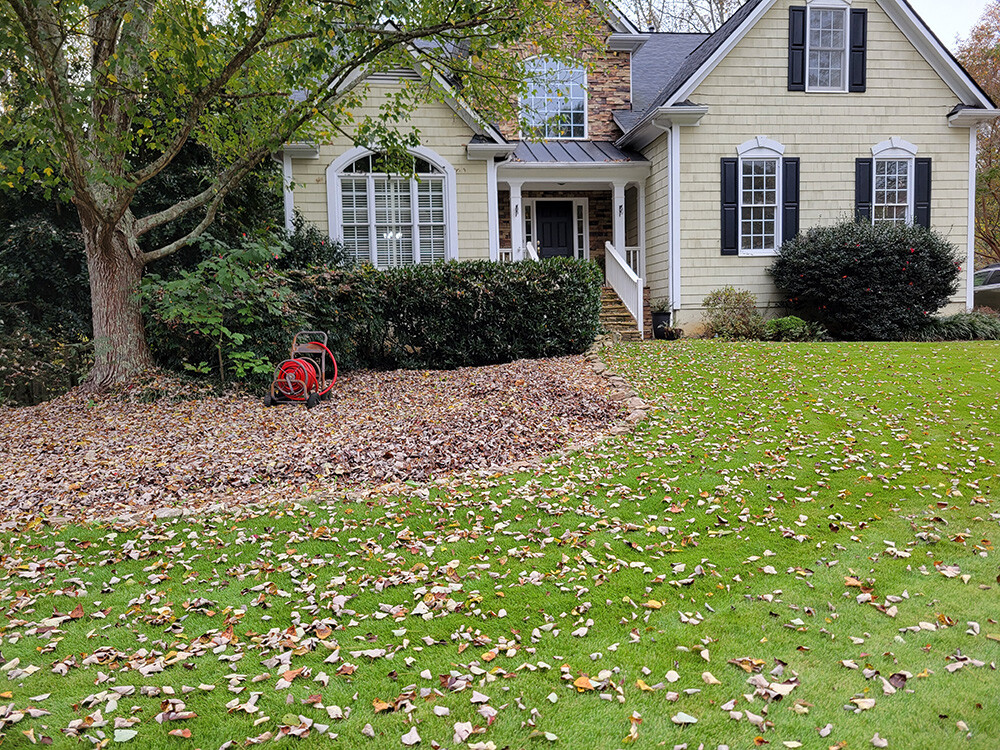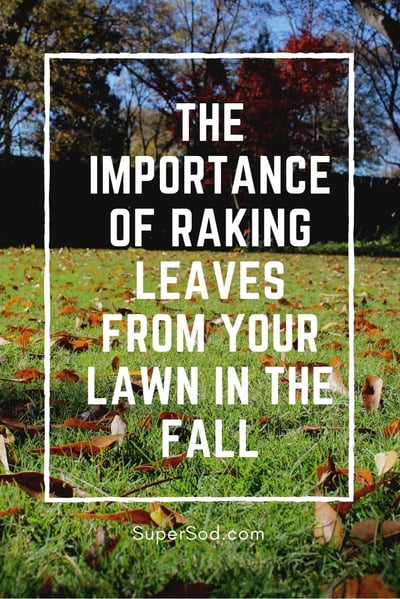

Why is it Important to Rake Fall Leaves from the Lawn?


Have you thought about why we're always raking and blowing leaves off our lawns? It's not just about keeping things tidy—there's a whole lot more to it!
While the colorful tree leaves add a splash of beauty, they can create hidden problems for your lawn. There are some misconceptions regarding keeping fallen leaves on lawns, so we want to explain why it's important to clear them off:
- Diseases: Fallen leaves lock in water underneath them, thus causing moisture to stay on lawn grass blades and augmenting fungal disease problems like large patch. The Super-Sod fall mantra is, “An ounce of prevention is cheaper and easier than curing disease in the spring!” In this case, removing the leaves is your ounce of prevention.
- Suffocation: Fallen leaves can suffocate or smother lawns, cutting them off from upward growth and the process of photosynthesis by depriving them of sunlight and the exchange of carbon dioxide and oxygen. This is especially true for Tall Fescue seedlings and also pertains to established Tall Fescue and warm season lawns (like Bermuda, Centipede, and Zoysia).
Keep your lawn healthy by raking those leaves away! The following paragraphs offer methods to clear leaves from your lawn and advice on what to do with them, ensuring a lush, healthy green space when spring arrives.
Bonus: These simple lawn maintenance tasks double as great exercise, helping you hit your fitness tracker goals!
Lawn Leaf Removal by Raking or Leaf Blowing
Rake fall leaves from the lawn using a sturdy leaf rake. Choosing the right rake can make all the difference. A metal rake is going to last the longest and allow you to dig deeply into the leaves to get a large mass of leaves at one time. We suggest investing in a quality metal leaf rake so you don’t have to purchase another one next year.
Lawn leaf raking also serves as a great family activity. Get some exercise and then play in the pile of leaves with your kids and dogs. For helpful little hands, you can purchase smaller rakes. The plastic ones will be fine for this if the kids want to pitch in before leaf-jumping.
Raking in the Bonuses: Leaf raking can help remove thatch that is built up in your lawn. This is less expensive than purchasing a dethatching attachment for your mower and a great alternative to scalping your lawn.
You might prefer to use a leaf blower to blow off leaves from your lawn. Leaf blowers are best for tackling large amounts of leaves from your lawn in one sweep. If you just have a few leaves or a small lawn, raking may take less time than fueling or charging a leaf blower and your neighbors will appreciate the lack of noise.
Use Leaves as Mulch or in Compost
Instead of bagging up those fall leaves from your lawn, why not use them to enrich your garden? Here's how to put those crisp autumn leaves to work.
Use leaves as mulch under trees and in flower and shrub beds
Simply blow leaves into nearby beds to act as a mulch. Mulch suppresses weeds while conserving moisture in the soil, a win-win for saving money and improving your landscaping. Other options are to rake/blow them:
- To the side towards a fence
- To the back of your property
- Into naturalized areas
- Under trees where they fall (like in nature, to nourish the trees by nutrient cycling)
There is no need to chop the leaves. The leaf piles will be large at first but you'll be surprised how rapidly they break down even over winter.
Use leaves to make compost
Add fallen leaves to your own compost pile. Over time, they break down and create organic matter that's full of nutrients and microbial life that will benefit your lawn and garden. Joe Lamp'l has advice for Using Fall Leaves in the Garden over on our Soil³ website.
Skip the brown bags and keep the goodness in your own landscape!
Frequently Remove Leaves from the Lawn
Remove fall leaves from the lawn once or twice week to make your job easier. Keep a consistent routine throughout the fall, and you won’t have to block off large chunks of hours during your weekend to rid the lawn of leaves. Depending on the size of your lawn, it could take less than an hour in the afternoon after you get home from work!
Spread Preventative Fungicide
Coupled with removing leaves from your lawn, we recommend an application of preventative fungicide in October to all warm season lawns. This is especially recommended if you've had trouble with the patch diseases, like "large patch," in the past.
Removing Leaves is Worth the Effort!
Next time you see those leaves piling up, remember it's worth the effort. By raking or blowing leaves from your lawn, you’re accomplishing these goals:
- Preventing Fungus: Leaves trap moisture, leading to disease.
- Keeping Grass Breathing: Leaves can suffocate your lawn.
- Enjoying the Outdoors: Raking is a great fall workout!
- Saving on Future Lawn Care: By taking action now, you'll save money on fungicides and patching areas of your lawn come springtime.
If you have questions about leaf removal from lawns, let us know in the comments below.





